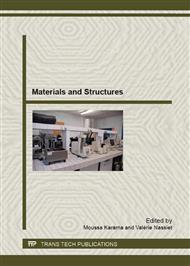p.17
p.25
p.33
p.41
p.49
p.57
p.65
p.73
p.85
Free Vibration Analysis of FGM Plates under Initial Thermal Stresses
Abstract:
Functionally graded materials (FGMs) are a new kind of composite materials which have a smooth variation of material properties along one or more directions. At each interface, the material is chosen according to specific applications and environment loadings. This paper presents some solutions to study the free vibration of FGM plates made of ceramic and metal. The formulation used is based on Reddys higher order shear deformation plate theory. Material properties are taken to be temperature-dependent, and vary continuously through the thickness direction according to a power law distribution (P-FGM). The plate is assumed to be initially stressed by temperature rise through the thickness. The energy functional of the system is obtained by using energy principles. Free vibration frequencies are then obtained by using a set of characteristic orthogonal polynomials and by applying Ritz method.
Info:
Periodical:
Pages:
49-56
Citation:
Online since:
April 2013
Authors:
Price:
Сopyright:
© 2013 Trans Tech Publications Ltd. All Rights Reserved
Share:
Citation:


